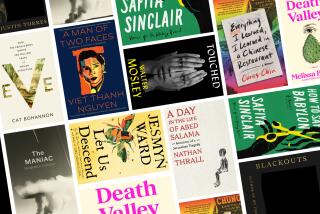MEMOIRS OF A GEISHA.<i> By Arthur Golden</i> .<i> Alfred A. Knopf: 392 pp., $25</i>
- Share via
Would “Memoirs of a Geisha” be so remarkable if it weren’t written by a white American male? Would the first-person story of the hardship and ritual of a geisha’s life in the Gion district of Kyoto during the 1930s and ‘40s be less fascinating if it were based on personal experience rather than on a brilliant alchemy of research and imagination? Certainly, the feat of an outsider capturing an alien world makes us marvel. Voice is central to literature, and Arthur Golden, who has degrees in Japanese art and history from Harvard and Columbia, has managed to disguise, alter and project his with the skill of a talented ventriloquist and impersonator. He has created an utterly convincing fiction that is also stirring and beautiful.
“Memoirs of a Geisha” is a bravura performance, a first novel that provides a vivid view into a largely lost and secret world. Golden tells a mesmerizing story of a poor fisherman’s daughter named Chiyo, who in the 1930s is sold into slavery at age 9. Her unusual striking blue-gray eyes catch the attention of the wealthy owner of the Japan Coastal Seafood Co. Chiyo is foolish enough to think he might adopt her and thus rescue her from her destitute “tipsy house” on the Sea of Japan before her elderly father and cancer-ridden mother die. Instead, he arranges for her father to sell both Chiyo and her older sister to people in Kyoto who are all too willing to make use of them. Chiyo, being more attractive, is sent to an okiyo, a boarding house for geisha, while her hapless sister goes to a brothel. The cruelty and exploitation they endure rival that found in Dickens’ “Oliver Twist” and instantly arouse the reader’s indignation and sympathy.
There is a pecking order in the Nitta okiyo, and young maids like Chiyo who have been bought to become income-producing geisha are at the very bottom. Well above them are the geisha whose fees for entertaining men at teahouses and parties and for serving as long-term mistresses to the highest-bidding patrons support the okiyo. When Chiyo arrives, the house of Nitta has just one money-earner, Hatsumomo, who is beautiful but “cruel as a spider.” She in turn is dominated by the three heads of the household: Granny, a mean, ravaged former geisha, and her two adopted daughters, called Auntie and Mother. Auntie, who did not grow up to be as pretty as Granny had hoped and thus never achieved success as a geisha, limps due to a hip broken years ago in one of Granny’s vicious beatings. The red-eyed Mother manages the complicated accounts and cares only about money.
These three wreckages of women are as nasty as any characters to be found in Dickens, but the queen of mean is Hatsumomo, who is determined to rule the roost and suppress all rivals. Golden only hints at the unhappiness that soured these women; more detail might have led to a more sympathetic, balanced portrait. Instead, his Hatsumomo is relentlessly awful. From the start, she sets out to sabotage Chiyo’s chances of becoming a geisha. She frames her for theft and vandalism, for which Chiyo is punished and beaten. Worse, deemed an unwise investment after a desperate escape attempt, Chiyo is pulled from the classes in dance, music and tea ceremony that might enable her to elevate herself. Her situation looks hopeless until a chance encounter with the kindly chairman of Iwamura Electric Co., who makes her resonate “like a temple bell . . . long after it has been struck.” Her fortunes start to turn after Hatsumomo’s rival, the lovely and refined Mameha, steps in to help her as a sort of mentor.
Golden’s novel is propelled forward by two thrusts: one of abiding hate, the other of abiding love. Will Chiyo--later Sayuri, after she becomes a geisha--triumph over Hatsumomo? And will she ever win the chairman’s affection? Along the way there are bumps and hurdles aplenty, including forced associations with other men, most of them repulsive to her, and World War II, which is followed by “a decade of crushed hopes.”
The reader is immersed in the world of these powerless “butterflies of the night,” with endless rounds of parties at which they entertain businessmen with silly small talk and drinking games. Golden describes the geisha’s elaborate, highly stylized dress: from painstakingly achieved hairdos that require sleeping on special neck cradles to exquisite silk kimonos with long sashes called obi tied in the back by male dressers. (One sign of prostitutes, geisha’s “lower-class counterparts,” is that they tie their obi in front for easier access.) Golden stresses that geisha are artisans as much as courtesans, and he provides telling details as to how they disguise their faces with white makeup and their emotions with noh mask smiles. Yet Golden doesn’t let us forget the sensitive individuals behind the performers and the tensions between their public and private selves.
Sayuri’s narrative is filled with images of water: water that wears down stones, runs into dams that seem insurmountable, scalds like Hatsumomo’s personality and freezes into ice during particularly bleak periods--all expressing her plight and evoking images of Japanese art and culture with the conciseness of haiku. Golden is particularly adept at employing language that is at once poetic and brutal to describe rituals that are astonishing and aberrant. One of the seminal moments in a geisha’s life is her mizuage, or loss of virginity, which goes to the highest bidder among her male patrons. Mameha explains sex to 15-year-old Sayuri as it had been explained to her when she was a girl, in terms of the male’s “homeless eel” in search of an inviting female cave. “A woman’s cave is particularly special to a man if no other eel has ever been in it before,” Mameha explains.
The subject of geisha, like prostitutes, is a natural attention-grabber, arousing easy prurient interests. What a delight, then, to find the subject treated with intelligent forthrightness and delicacy in this day of no-holds-barred lasciviousness. “Memoirs of a Geisha” provides a far more vibrant view of a geisha’s life than the dry short novel of 1952, “A Geisha Remembers,” written by Masuji Ibuse (best known for “Black Rain”) or studies such as Cecilia Segawa Seigle’s 1993 “Yoshiwara: The Glittering World of the Japanese Courtesan.” It is a remarkable achievement for any writer, but especially for a white male from a markedly different culture.
More to Read
Sign up for our Book Club newsletter
Get the latest news, events and more from the Los Angeles Times Book Club, and help us get L.A. reading and talking.
You may occasionally receive promotional content from the Los Angeles Times.










